Keyword Research Tutorial: Step By Step
During my journey through the intricate world of SEO, I quickly realized the cornerstone of any successful online presence is mastering the keyword research.
This “Keyword Research Tutorial” is not just another guide; it’s a reflection of my own experiences, learned hands-on through countless hours navigating the depths of Ahrefs Keyword Research.
I’ve distilled these insights into a comprehensive walkthrough, aimed at transforming how you approach SEO—from understanding the subtleties of search intent to leveraging the power of strategic keyword placement.
Whether you’re starting your first blog or looking to refine your existing content strategy, join me as we talk about the nuances of keyword research, making it an invaluable tool in your SEO plan.
This tutorial promises to equip you with the knowledge and skills necessary to grow your website’s visibility, drive targeted traffic, and ultimately, convert your audience into loyal customers.
So, Whether you’re launching a brand-new website or aiming to enhance your existing keyword strategy, the techniques I’m about to share are pivotal for your SEO success.
Today’s insights are designed to help your online presence, ensuring that your content not only ranks higher in search engine results but also resonates with your target audience.
By refining your approach to keyword targeting, you’ll set the foundation for a more visible and engaging website that captivates and converts.
Step 1: Generate keyword ideas – Keyword Research
Generate keyword ideas is the foundation of SEO success. In this very this essential phase, I am using Ahrefs Keywords Explorer, a powerful tool that has been instrumental in my own SEO ventures. By inputting broad keywords relevant to niches—such as “SEO,” “Content Writing,” “Social Media,”—I’m not just casting a wide net; I’m setting the stage for a targeted approach that aligns with the online store’s offerings.
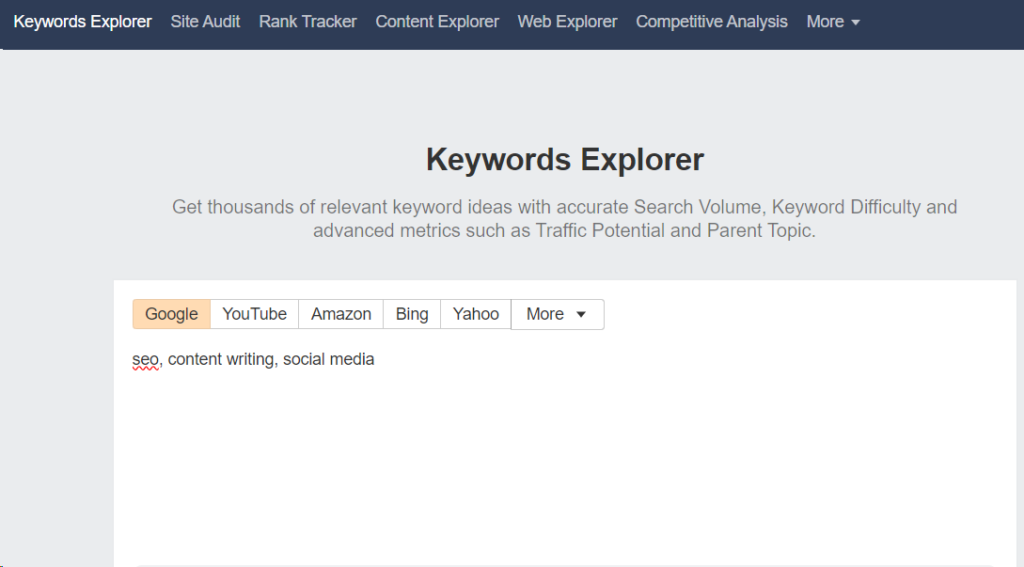
- Exploring Matching Terms: When I Utilized the “Matching Terms” report within Ahrefs, I’m greeted with over 435,840 keyword possibilities. Yet, the goal here isn’t to amass a random collection of terms but to meticulously filter and categorize these keywords by their search intent.
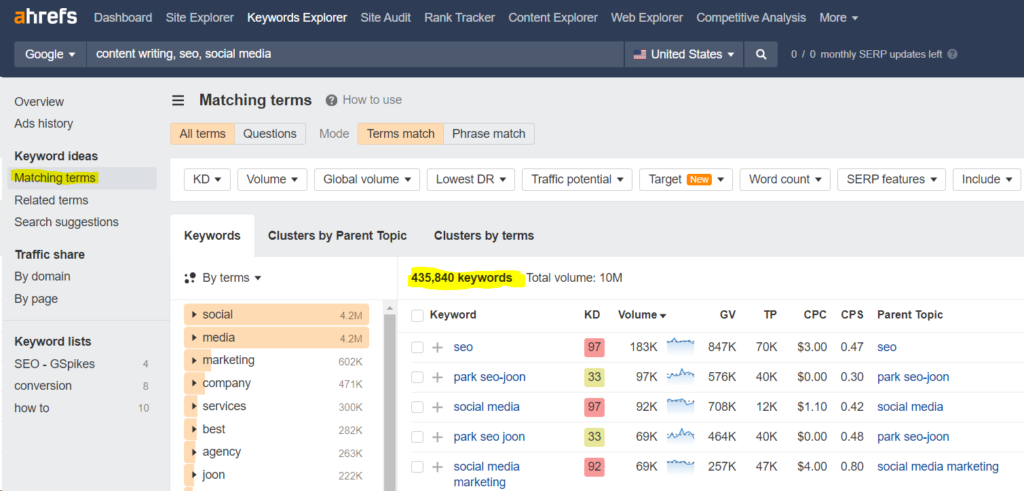
Step 2: Determine Search Intent For A Keyword
Understanding the searcher’s underlying intent is paramount. This can typically be segmented into four distinct categories:
- Informational (seeking knowledge),
- Navigational (looking for a specific destination),
- Commercial investigation (comparing options with a purchase in mind),
- Transactional (ready to buy).
Each category plays a unique role in the consumer’s journey, from awareness to decision-making.
| Informational | Navigational | Commercial investigation | Transactional |
| how | brand names | best | buy |
| what | name of a product | top | coupon |
| who | name of a service | pricing | order |
| where | review | purchase | |
| why | attribute of a product | cheap | |
| guide | comparison | price | |
| tutorial | pricing | ||
| resource | |||
| ideas | |||
| tips | |||
| learn |
Beyond Transactional Keywords: While the allure of transactional keywords is undeniable for their direct path to revenue, focusing solely on these can severely limit reach and potential engagement. Informational content, for instance, not only builds trust and authority but also introduces your brand earlier in the buying cycle, creating opportunities for conversion through strategic content like blog posts that address common queries or concerns.
Strategic Filtering for Maximum Impact: Now going back to Ahrefs’ Keyword Explorer, I refine my search by intent, applying filters to hone in on keywords with sufficient search volume and manageable competition.
So i will take a list of the information keywords from the table above and paste them in the include box.
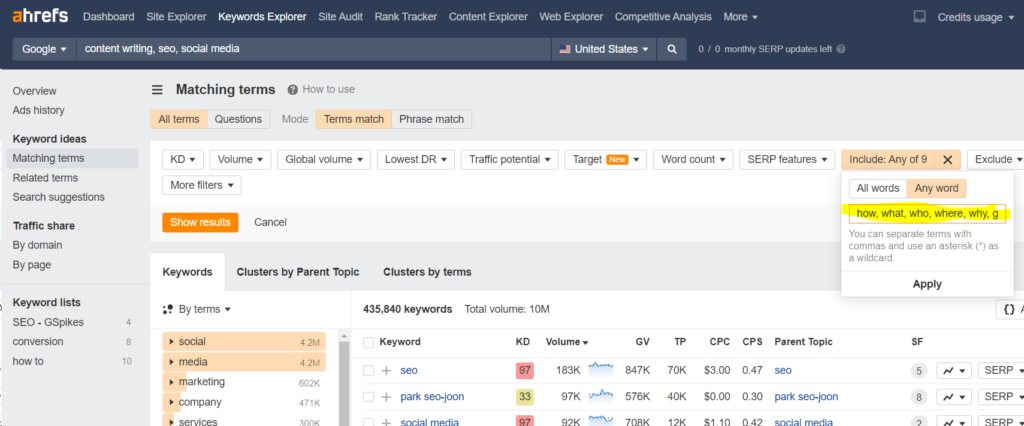
This process isn’t arbitrary; it’s about assessing the business potential of each keyword, ensuring relevance to my products and services, and considering the keyword’s ability to naturally integrate into my content.
After the first round of filtering, we still have a massive list of 46,320 keywords. That’s a lot, right? So, we need to narrow it down even further. Now, if you’re aiming for keywords that aren’t too tough to rank for, we can apply another filter.
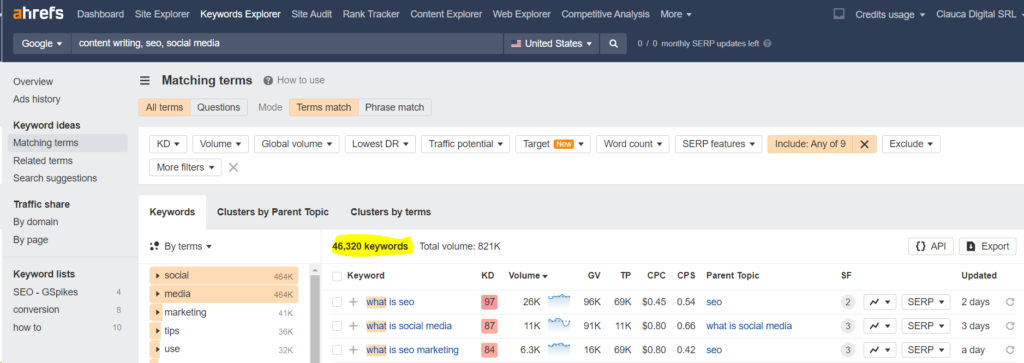
This time, we’re looking at how hard it is to compete for a keyword, which we call keyword difficulty. We set a cap on that difficulty at a low level, say around 10. This helps us weed out the really tough competition.
But here’s what I like to do: instead of just looking at how hard it is to rank, I focus on how many people are actually searching for these keywords. This is known as search demand. By setting our sights on keywords that at least 1,000 people search for each month, we ensure we’re targeting words that get enough attention but aren’t too crowded with competition.
By applying this method, we’ve dramatically cut down our list from that overwhelming 435,840 keyword to 3 keywords only. This way, we’re focusing our efforts on keywords that are not only easier to rank for but also have a decent number of people looking for them.
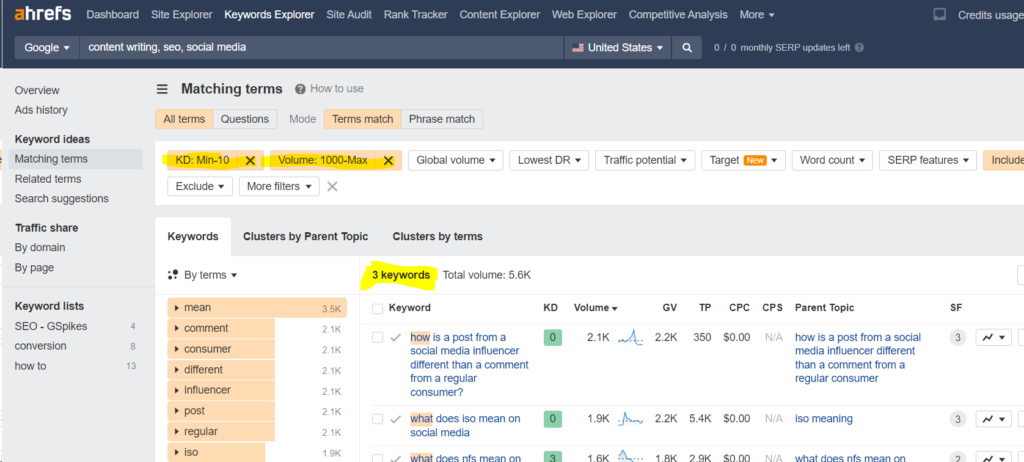
Curating a Targeted Keyword List: By examining keywords through the lens of search intent and business value, I’m crafting a curated list that spans the entire consumer journey. This isn’t just about attracting traffic—it’s about attracting the right traffic, the kind that leads to engagement, trust, and ultimately, conversions.
In these 2 steps, we can say that generating keyword ideas, is more than a task; it’s the foundation upon which successful SEO strategies are built. It requires a deep understanding of your audience, a strategic approach to search intent, and the savvy use of tools like Ahrefs to uncover opportunities that align with your business goals.
Before I move forward, remember that every keyword represents a question, a need, or a desire from your potential customers—your job is to answer, fulfill, and satisfy.
Step 3: Analyze Google’s Top 10 search results
Alright, let’s move to the next big thing I do: checking out Google’s top 10 search results for the keywords I’m interested in. This step is crucial, guys. It’s like doing a little detective work to see what’s already working and how tough the competition might be for those keywords on Google’s first page.
When you look at those top 10 results, it’s a goldmine of info. You get to see what type of content is ranking—like, are they blog posts, product pages, or something else?
This gives you a clue about what Google thinks is the best answer for that search query. For instance, when I looked up something about ISO in Social Media, all the top results were informative blog posts explaining what they are and what they mean. That’s a signal right there. Instead of trying to break into the ranking with. So, I’d go ahead and write a helpful blog post titled “What Does ISO Mean on Social Media.”
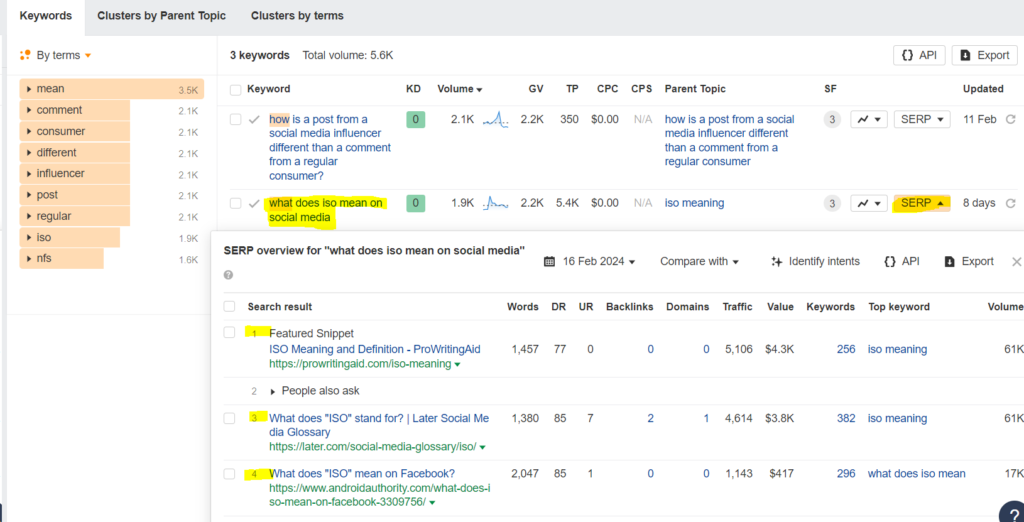
But here’s the thing, the type of content that ranks can vary a lot depending on what you’re searching for. Some of the top spots sometimes can be mostly taken by product and category pages, not articles. This tells me that for keywords like this, Google thinks people are in a buying mood, not just looking for information.
So, what I do is simply type the keyword into Google and see what comes up. This way, I can directly see what kind of content I should be creating and how I can customize my strategy to fit what’s already performing well. It’s all about playing smart and giving Google and your audience exactly what they’re looking for.

Step 4: Measure Ranking Difficulty – Keyword Research
Let me figure out with you how tough it’s going to be to climb up Google’s rankings for our chosen keyword. This part’s pretty key to my strategy. There are a couple of things I like to check out to make this call.
First off, I look at how many different websites are linking back to those pages that are already ranking. We call these backlinks from “referring domains.” When I peeked at the top dogs for my keyword, I noticed they didn’t have a ton of unique sites linking to them, except for maybe wikihow, which is always a beast on its own. Surprisingly, some of the pages lower down didn’t have any backlinks at all.
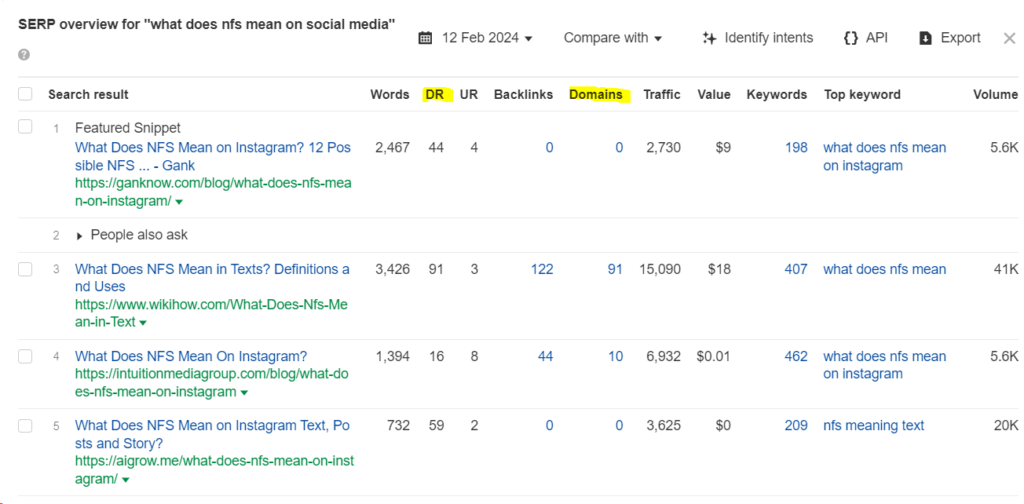
Now, while I’m snooping around these referring domains, I also take a look at something called Domain Rating (DR). This is a score that shows how strong a website’s overall backlink profile is. From what I saw, the sites at the top of the rankings are pretty strong competitors. So, if my site’s DR is around 15, which is not super high, I know I’m up against some heavy hitters.
Basically, the game plan is to either find keywords where the competition is more in my DR league or be ready to hustle harder to get more and better backlinks.
It’s all about knowing where you stand and how much elbow grease you’ll need to put in to get where you want to be in Google’s rankings.
Step 5: Analyze Topical Relevance – Keyword Research
The last piece of the puzzle for me is checking out how closely related the top-ranking content is to the specific topic I’m targeting.
Let’s talk about something like “ISO on Social Media,” which falls under the broader “Social Media” category. When I look at the top pages for this keyword, I see a bunch of high domain rating (DR) owning those spots. This clues me in that breaking into these rankings might be a bit tough since these websites are directly related to the topic and well-established in the field. However, it’s definitely not a lost cause.
Taking this into account, I start to think about how many backlinks—those are links from other websites pointing to mine—I might need to compete effectively.

This isn’t just a wild guess; I’m basing it on the strength and relevance of the existing top pages. Once I’ve got a ballpark figure, I weigh up whether it’s realistic for me to invest the necessary effort and resources to compete for this keyword. Is it worth the hustle? That’s the big question.
This approach isn’t just for one keyword. I do this for every keyword I’m thinking about targeting. And trust me, keeping track of all this info is way easier when you’ve got it all laid out in a spreadsheet. It’s like my roadmap for SEO strategy—helps me stay organized and focused on the keywords that are truly worth going after.
Step 6: Reverse-engineer Competitors’ Traffic Generating Pages
So, there’s this clever trick I use to come up with new keyword ideas: I basically spy on what’s working for my competitors. For instance, there’s this website in the digital marketing space, “eddyballe.” I’m curious about what topics are pulling in traffic for them because, let’s face it, we’re playing in the same league.
Here’s how I do it: I hop onto Ahrefs Site Explorer, punch in “eddyballe,” and check in directly into their Top pages report. This report is gold—it shows me which pages on their site are getting the most action.
If I were on the hunt for product pages that are hitting it big, I’d look for a site with lots of product page traffic, kind of like how shopify.com dominates in its niche. But since I’m all about that blog life, I’m more interested in sites like eddyballe.com that are killing it with their blog content.

Next, I just check through the data, focusing on the Traffic and Top keyword columns. This gives me a sneak peek at what topics are hot and what keywords they’re ranking for. And here’s a pro tip: if you’re looking to avoid a head-to-head battle with the big sites, check out the Referring Domains column. It gives you a clue about how tough it would be to rank for those topics.
Once I’ve got a potential topic in my sights, I check deeper. I start sorting these topics by search intent, thinking about how much value they could bring to my site, and sizing up how tough the competition is. It’s like assembling a puzzle where each piece brings me closer to nailing that perfect content strategy.
Conclusion about Keyword Research
Wrapping this up, I’ve learned that pulling in traffic with keyword research is just the beginning.
The real magic happens when those keywords deeply connect with what my potential customers are actually looking for.
It’s like solving a puzzle where each piece represents a challenge they’re facing. My job? To make sure my content doesn’t just rank well but actually answers their questions, solves their problems, and makes their lives better.
This whole journey is about more than just numbers and rankings; it’s about understanding people.
By carefully choosing keywords that match the real needs of my audience, I’m not just aiming for clicks—I’m building a bridge to real solutions they’ve been searching for.
And when I get this right, it’s not just about getting them to visit my site; it’s about leading them to that moment of realization where they see the value in what I’m offering. That’s the conversion. And that’s the ultimate goal of all this keyword research: to not only reach my audience but to resonate with them in a way that genuinely helps.






